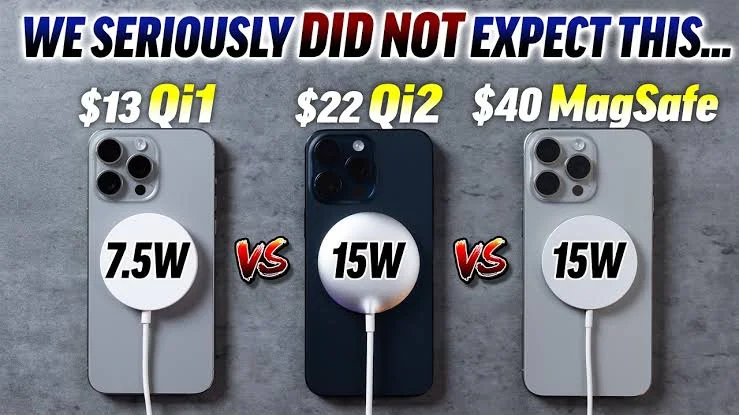Understanding Qi, Qi2, and MagSafe Wireless Charging Technologies
 |
| Understanding Qi, Qi2, and MagSafe Wireless Charging Technologies |
Wireless charging has evolved significantly over the years, and three key technologies dominate the space: understanding Qi, Qi2, and MagSafe. While they all aim to make charging more convenient, each has unique features and improvements. Let's break them down and compare their key differences.
What is Qi2, and How Does It Compare to Qi and MagSafe?
Qi2 is an upgraded wireless charging standard developed by the Wireless Power Consortium (WPC). It introduces several enhancements over the original Qi standard, primarily through the Magnetic Power Profile (MPP). This feature, inspired by Apple’s MagSafe technology, ensures better alignment and improved efficiency during charging. Notably, Apple played a significant role in shaping Qi2’s development.
10 Key Differences Between Qi, Qi2, and MagSafe
1. Magnetic Alignment
- Qi: Requires precise manual placement, often leading to misalignment and reduced efficiency.
- Qi2: Incorporates the Magnetic Power Profile (MPP) for automatic alignment using magnets.
- MagSafe: Pioneered magnetic alignment for iPhones with a built-in ring of magnets.
2. Charging Speed
- Qi: Supports speeds ranging from 5W to 15W, but iPhones are capped at 7.5W on non-MagSafe chargers.
- Qi2: Standardizes 15W charging across all compatible devices for reliable performance.
- MagSafe: Delivers 15W for most iPhones, while the iPhone 16 series supports up to 25W with Apple’s latest charger.
3. Cross-Platform Compatibility
- Qi: Works with all Qi-certified devices, including both Android and iPhones.
- Qi2: Expands compatibility to both iOS and Android, breaking MagSafe’s Apple-exclusive barrier.
- MagSafe: Designed exclusively for Apple devices (iPhone 12 and newer).
4. Backward Compatibility
- Qi2: Works with older Qi devices, though legacy Qi chargers may not fully support Qi2 devices.
- MagSafe: Can charge Qi-enabled devices but operates at reduced speeds (7.5W).
5. Certification Requirements
- Qi2: Requires official WPC certification to carry the Qi2 logo, ensuring compliance with MPP standards.
- MagSafe: Needs Apple’s "Made for MagSafe" certification to unlock 15W+ speeds.
6. Heat Management
- Qi: Misalignment can cause energy loss and overheating.
- Qi2 & MagSafe: Magnetic alignment minimizes energy waste, significantly reducing heat generation.
7. Accessory Ecosystem
- MagSafe: Offers a robust selection of Apple-first accessories (e.g., wallets, mounts, power banks).
- Qi2: Expands support to Android, enabling a broader range of cross-brand magnetic accessories.
8. Adoption and Availability
- Qi: Has been widely adopted since 2008 and is supported by most smartphones.
- Qi2: A newer standard that is still rolling out, with limited adoption so far (e.g., HMD Skyline, Samsung’s Qi2-ready Galaxy S25).
- MagSafe: A well-established technology in Apple’s ecosystem since 2020.
9. Future-Proofing
- Qi2: Designed to support higher wattages (50W+ charging planned).
- MagSafe: Apple has already introduced 25W support for the iPhone 16 series, but future upgrades remain under Apple’s control.
10. Implementation Flexibility
- Qi2-Ready: Allows non-magnetic phones (e.g., Samsung Galaxy S25) to benefit from Qi2 charging via compatible magnetic cases.
- MagSafe: Requires built-in magnets, limiting flexibility for non-Apple devices.
Quick Comparison Table
| Feature | Qi | Qi2 | MagSafe |
|---|---|---|---|
| Alignment Method | Manual | Magnetic (MPP) | Apple’s proprietary magnetic system |
| Charging Speed | Up to 15W (iPhones limited to 7.5W) | Standardized 15W | 15W (25W for iPhone 16 series) |
| Compatibility | Universal | Cross-platform (iOS & Android) | Apple-only (iPhone 12+) |
| Backward Compatibility | No special requirements | Backward-compatible with Qi | Works with Qi but at lower speeds |
| Certification | Basic WPC certification | Strict Qi2 MPP certification | Requires Apple’s MFi certification |
| Heat Generation | Higher due to misalignment | Improved thermal management | Optimized heat dissipation |
| Accessories | Open ecosystem | Growing support for cross-brand accessories | Established Apple accessory ecosystem |
| Launch Year | 2008 | 2023+ | 2020 |
| Future Upgrades | Limited | 50W+ planned | Apple-controlled updates |
| Magnet Requirement | None | Optional (via magnetic cases) | Built-in magnet array required |
Conclusion
Qi2 brings the best of both worlds—Qi’s universal compatibility and MagSafe’s precision—delivering a faster, safer, and more efficient wireless charging experience for both iOS and Android users. While MagSafe remains the premium choice for Apple devices, Qi2’s broader compatibility and WPC-backed standardization make it a promising future-proof charging solution. Keep an eye on its adoption as more manufacturers integrate it into their devices.
For further details, visit the Wireless Power Consortium’s official website or check out the latest updates from leading smartphone manufacturers.

Comments
Post a Comment